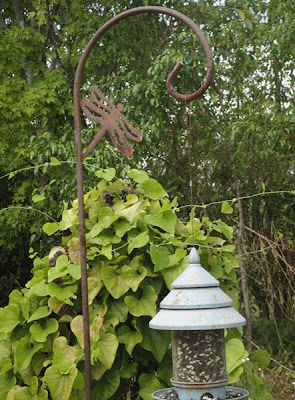 It's here! I have an officially certified backyard wildlife habitat!
It's here! I have an officially certified backyard wildlife habitat!Long before our kids were born, my husband and I worked on making our yard friendly to wildlife. We learned what wildlife need: shelter, water, food and a place to raise their young. It was easy to make sure our yard had all of those elements. We knew about the National Wildlife Federation's Certified Wildlife Habitat program, but we just never got around to certification.
When I heard recently the NWF is hoping to reach 150,000 yards certified, I finally filled out the forms online. (See on my certificate, I'm number 139,834.) It's a simple process.
If you want to be
Shelter

See this dead tree in my yard? It's called a snag. And it's great for wildlife! A rock pile or rock wall or even thick brush work too.
Water
Wildlife also need a source of water. We live on a canal that attracts wading birds like herons and egrets, and it's also home to turtles. A bird bath in our wildflower garden gives smaller birds a place to find fresh water.
Food
Our yard also provides sources of food for critters, like the queen palm seeds that I've seen raccoons eat:

The firebush that gives butterflies nectar:

Cocoplum bushes that will eventually fruit (and I see something has been eating the leaves):

Several bird feeders that attract different birds at different times of the year:

Place to Raise Young
Behind the bird feeder in the picture is a Dutchman's pipe vine, which is a larval host plant, aka food for caterpillars that grow into swallowtail butterflies.
My husband built a nesting box that is just the right dimensions for an American kestrel or a northern screech owl. (But most of the time, it houses squirrels, and that's OK too.) One time, he put a video camera in the box and recorded an owl making a nest there. Sure wish I could find that video! Another time, bees made a hive in there.

If you don't want to make a nesting box, that's OK because many animals live in trees. If you have a tree in your yard, that might be a good place for a critter to nest.

Sustainable Gardening
Do you use mulch? Maybe you compost or have a rain barrel? These are beneficial to wildlife too. We avoid using pesticides in or around our yard because we don't want to kill off the butterflies we have worked hard to attract by planting nectar and larval plants.
You can see it doesn't take much to attract wildlife to your yard -- after that, it's just a matter of filling out the Certified Wildlife Habitat form and paying the fee ($20). Then tell all your friends, who will think you are an awesome wildlife expert.






